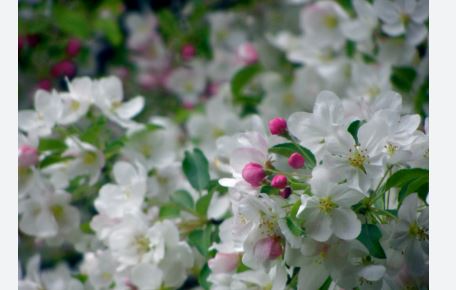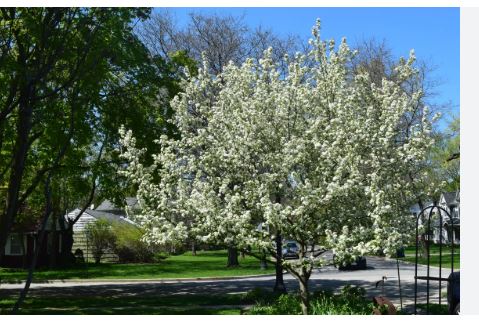
The Evereste Crabapple (Malus PERPETU ‘Evereste’) is a charming, disease-resistant ornamental tree renowned for its profuse white spring blossoms, vibrant orange-red fruit, and compact, conical form. As a standout cultivar in the Malus genus, this deciduous tree is a favorite among gardeners, landscapers, and urban planners for its year-round beauty, low-maintenance care, and ability to thrive in diverse environments.
Botanical Classification
The Evereste Crabapple belongs to the following taxonomic classification:
- Kingdom: Plantae
- Phylum: Tracheophyta
- Class: Magnoliopsida
- Order: Rosales
- Family: Rosaceae
- Genus: Malus
- Cultivar: PERPETU ‘Evereste’
The Malus genus includes both apples and crabapples, with crabapples defined by their smaller fruit (less than 2 inches in diameter). The Evereste Crabapple, registered under the trademark Malus PERPETU ‘Evereste’, is a hybrid cultivar developed for its ornamental qualities, disease resistance, and adaptability. Its classification reflects its cultivated status, with no specific species designation due to its hybrid lineage, likely involving Malus baccata, Malus floribunda, or other Asian crabapple species.
History of the Evereste Crabapple
The Evereste Crabapple was developed in 1974 by the Institut National de la Recherche Agronomique (INRA) in Angers, France, as part of a breeding program to create disease-resistant, aesthetically pleasing crabapples. Named after the iconic Mount Everest, this cultivar was selected for its robust performance and stunning visual appeal, earning the prestigious Award of Garden Merit from the Royal Horticultural Society in 1993.
The tree’s development focused on combining profuse flowering, persistent fruit, and resistance to common crabapple diseases like apple scab, fire blight, cedar-apple rust, and powdery mildew. Royalties from its sales in the United States support tree fruit research, such as programs at Western Washington Tree Fruit Research.
Crabapples trace their origins to the mountainous regions of Central Asia, particularly Kazakhstan, where the wild apple species Malus sieversii is considered the ancestor of modern apples and crabapples. These trees spread across Europe and Asia via the Silk Road and were introduced to North America by European colonists in the 17th century for cider production and ornamental use.
Native North American crabapple species, such as Malus coronaria (sweet crabapple) and Malus fusca (Pacific crabapple), also contributed to the genetic diversity of cultivated crabapples. The Evereste Crabapple represents a modern advancement, blending European breeding expertise with the hardy traits of its Asian and North American ancestors.
Native Area
As a cultivated hybrid, the Evereste Crabapple does not have a true native range but is derived from Malus species native to temperate regions of the Northern Hemisphere, including Central Asia (e.g., Kazakhstan, Russia, and China) and parts of North America.
Its likely ancestors, such as Malus baccata (Siberian crabapple) and Malus floribunda (Japanese flowering crabapple), originate from Asia. Native North American species like Malus coronaria (eastern U.S.) and Malus fusca (Pacific Northwest and Alaska) may have influenced its genetic lineage. Developed in France and widely distributed in North America and Europe, the Evereste Crabapple is highly adaptable, thriving in urban and rural landscapes across temperate climates.
Identifying Characteristics

The Evereste Crabapple is celebrated for its compact form, vibrant seasonal displays, and four-season interest.
- Size and Shape: This small deciduous tree grows to a height of 15–22 feet with a spread of 15–20 feet, forming a broadly conical to rounded canopy. Its compact, symmetrical shape makes it ideal for small gardens, urban spaces, or formal landscapes.
- Foliage: The leaves are elliptical to slightly lobed, 2–3 inches long, with serrated margins. They emerge dark green in spring, maintaining a glossy appearance through summer. In fall, the foliage turns yellow to orange, creating a warm, vibrant display that complements the persistent fruit.
- Flowers: In late spring (April–May), the tree produces masses of large, fragrant, cup-shaped white flowers (2 inches across) that open from rich red or pink buds. The five-petaled blooms, arranged in clusters (corymbs), have a pinkish tint when first open, creating a stunning contrast with the dark green foliage. The flowers attract pollinators like bees, butterflies, and hummingbirds, enhancing garden biodiversity.
- Fruit: Following the blooms, the tree develops abundant clusters of cherry-like, red-blushed, orange-yellow pomes (1 inch in diameter), which ripen in autumn (September–October) and persist into winter (December–January). These small, decorative fruits are tart but edible and add vibrant color to the winter landscape.
- Bark: The bark is greyish-brown, smooth when young, and becomes slightly scaly or fissured with age. It provides subtle texture to the tree’s winter silhouette.
- Growth Habit: The tree’s broadly conical to rounded form, with dense, twiggy branching, creates a tidy, formal appearance. Its compact size and strong structure make it suitable for restricted spaces or as a focal point in landscapes.
Uses of the Evereste Crabapple
The Evereste Crabapple is primarily an ornamental tree, valued for its aesthetic appeal, ecological benefits, and versatility. Its uses include:
- Landscaping: The tree’s compact size, profuse blooms, and persistent fruit make it ideal for specimen planting, accent trees, street trees, patio trees, or group plantings. Its conical form suits small gardens, urban courtyards, formal landscapes, or cottage gardens. It can be planted under power lines or used as a privacy screen when spaced 10–15 feet apart.
- Wildlife Support: The fragrant flowers attract pollinators like honeybees, bumblebees, mason bees, and butterflies, supporting early-season pollination. The persistent fruits provide a food source for songbirds (e.g., robins, cedar waxwings) and small mammals (e.g., squirrels) from autumn through winter, enhancing biodiversity. The tree also serves as a host plant for butterfly and moth larvae.
- Culinary Uses: The tart, 1-inch fruits are suitable for jellies, preserves, applesauce, or cider due to their high pectin content. While not typically eaten raw due to their sour flavor, they can be sweetened and cooked for culinary use, adding a tangy, apple-like flavor to recipes. The fruits’ vibrant color makes them ideal for decorative food presentations.
- Pollination: The Evereste Crabapple is self-sterile, requiring cross-pollination with another Malus cultivar (e.g., other crabapples or eating apples like Arkansas Black) blooming at the same time (early to mid-season). It is an excellent pollinator for self-sterile apple trees, boosting fruit yields in home orchards due to its long bloom period and copious pollen production.
- Urban and Commercial Use: Its high tolerance for urban pollution, drought, and poor soils makes it a top choice for city parks, parking lot islands, streetscapes, or commercial properties. Its disease resistance reduces maintenance costs, and its compact size fits constrained urban spaces.
- Bonsai and Espalier: The tree’s attractive branching and compact form make it suitable for bonsai or espalier training, adding artistic flair to small gardens or patios.
- Medicinal and Traditional Uses: Historically, crabapple fruits and bark have been used in traditional medicine by Indigenous peoples for digestive issues, gout relief, or as an eyewash due to their malic and tartaric acid content. While not a primary use for Evereste, its fruits share these properties.
Growth Rate
The Evereste Crabapple has a moderate growth rate, adding 12–18 inches per year under optimal conditions. It reaches flowering and fruiting maturity within 3–5 years and achieves its mature height of 15–22 feet in approximately 8–12 years.
On mini-dwarf rootstocks (e.g., M27), it may remain as small as 5–8 feet, ideal for very small gardens. Its relatively fast establishment and long lifespan (up to 50 years with proper care) make it a reliable choice for landscapes seeking lasting beauty.
USDA Hardiness Zones
The Evereste Crabapple thrives in USDA Hardiness Zones 4–8, tolerating winter temperatures as low as -30°F and performing well in warm, temperate summers. It requires 500–600 chill hours (hours below 45°F) to break dormancy and set fruit reliably, making it less suited for warmer climates like USDA Zone 10b.
The tree prefers full sun (6+ hours daily) to maximize flowering, fruiting, and foliage color, but it tolerates partial shade with reduced bloom and fruit production. It grows best in moderately moist, well-drained, slightly acidic soils (pH 5.0–6.8) but adapts to a wide range of soil types, including clay, loam, and sandy soils. Once established, it is drought-tolerant, pollution-resistant, and moderately tolerant of salt spray, making it ideal for urban and coastal plantings.
Fun Fact
The Evereste Crabapple’s name, inspired by Mount Everest, reflects its towering beauty and resilience, much like the world’s highest peak. Developed by INRA in France, it was selected as the most disease-resistant and visually stunning cultivar in extensive crabapple trials, earning it a reputation as a “peak performer” in ornamental horticulture. Its ability to thrive in challenging urban environments and its support for pollinators make it a true summit of garden excellence.
Care and Maintenance Tips
To ensure the Evereste Crabapple thrives, follow these care tips:
- Planting: Choose a sunny, well-drained site with good air circulation to minimize disease. Dig a hole twice as wide and as deep as the root ball, incorporating peat moss or compost to enrich slightly acidic soil. Plant in spring or fall, ensuring the root ball’s top is slightly above ground level. Water deeply and apply a 2–3-inch layer of organic mulch (e.g., wood chips), keeping it away from the trunk.
- Watering: Water regularly (weekly, 12–15 gallons) during the first year to establish roots, using the “finger test” (water if soil is dry 2 inches down). Once established, water during prolonged dry spells or extreme heat. Avoid overwatering to prevent root rot.
- Pruning: Prune in late winter or early spring before bud break to remove dead, diseased, or crossing branches, water sprouts, and suckers. Minimal pruning is needed to maintain its conical shape, but thinning the canopy improves air circulation and reduces disease risk. Sanitize tools between cuts to prevent infection.
- Fertilization: If planted in fertile soil, fertilization is rarely needed. In poor soils, apply a slow-release, balanced fertilizer (e.g., 10-10-10) or compost in early spring before growth begins. Avoid over-fertilizing to prevent excessive vegetative growth and disease susceptibility.
- Pest and Disease Control: The Evereste Crabapple has excellent resistance to apple scab, cedar-apple rust, and powdery mildew but is slightly susceptible to fire blight in humid conditions. Monitor for minor pests like aphids, Japanese beetles, or spider mites, which can be managed with horticultural soap or beneficial insects like ladybugs. Regular inspection and good site selection minimize issues.
- Site Selection: Plant 10–15 feet from buildings or other trees to accommodate its mature spread and ensure air circulation. Avoid areas with heavy road salt exposure, as salt tolerance is moderate.
Challenges and Considerations
While the Evereste Crabapple is low-maintenance, consider the following:
- Fire Blight Susceptibility: Though highly disease-resistant, it is slightly susceptible to fire blight in wet, humid climates. Proper pruning and site selection with good air circulation reduce risks.
- Fruit Drop: The persistent fruits are small and decorative, but some may fall in late winter, requiring minimal cleanup in high-traffic areas.
- Pollination Requirements: As a self-sterile tree, it requires a nearby Malus cultivar (e.g., another crabapple or apple tree) blooming simultaneously for fruit production. Ensure a compatible pollinator is within 50–100 feet.
- Seed Toxicity: Like all Malus species, the seeds contain trace amounts of amygdalin, which can break down into cyanide if crushed and ingested in large quantities. The risk is minimal, as the tart fruits are not typically consumed raw, and whole seeds pass through the digestive system harmlessly.